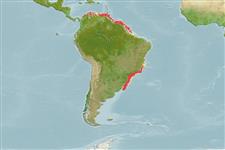Actinopterygii (ray-finned fishes) >
Perciformes (Perch-likes) >
Sciaenidae (Drums or croakers)
Etymology: Ctenosciaena: Greek, kteis, ktenos = comb + Greek, skiaina = barbel, red mullet (Ref. 45335).
Environment / Climate / Range
Ecology
Marine; demersal; depth range 10 - 130 m (Ref. 9626), usually 10 - 80 m (Ref. 3702). Tropical, preferred ?; 13°N - 34°S, 77°W - 38°W
Western Atlantic: Nicaragua along the Caribbean coast and Atlantic coasts of South America to southern Brazil.
Size / Weight / Age
Maturity: Lm ? range ? - ? cm
Max length : 21.0 cm TL male/unsexed; (Ref. 9626); common length : 16.0 cm TL male/unsexed; (Ref. 3702)
Dorsal
spines
(total): 11;
Dorsal
soft rays
(total): 21-24;
Anal
spines: 2;
Anal
soft rays: 7 - 8. Body silvery, grey on back and white on belly. Inside of opercle lining black, appearing as a dark triangular blotch externally. Base of pectoral fin and axil with a dark spot. Upper half of spinous dorsal fin dusky. Other fins pale. Mouth moderately large, slightly inferior. Tip of chin with a pointed flexible barbel. Gas bladder carrot-shaped, without appendages. Sagitta (large earstone) thick and ovoid, lapillus (small earstone) rudimentary (Ref 51721).
Inhabits coastal waters, usually over sandy mud bottoms (Ref. 3702). Feeds mainly on shrimps (Ref. 3702). Important food fish.
Life cycle and mating behavior
Maturity | Reproduction | Spawning | Eggs | Fecundity | Larvae
Cervigón, F., 1993. Los peces marinos de Venezuela. Volume 2. Fundación Científica Los Roques, Caracas,Venezuela. 497 p. (Ref. 9626)
IUCN Red List Status (Ref. 115185)
CITES (Ref. 94142)
Not Evaluated
Threat to humans
Harmless
Human uses
Fisheries: minor commercial; bait: usually
More information
ReferencesAquacultureAquaculture profileStrainsGeneticsAllele frequenciesHeritabilityDiseasesProcessingMass conversion
Tools
Special reports
Download XML
Internet sources
